Harvest festivals, open cellars, wine trails and old-fashioned grape picking – here are 18 of the best places in Europe to visit during wine harvest season.
For countries with a heritage of viniculture, the annual grape harvest is an auspicious time of year. Europe’s wine regions come alive with events that showcase regional heritage and local produce, and festivities that mark the passing of summer.
Wine lovers, gastronomes and cultural tourists alike will find harvest season one of the best times to visit the continent. This list brings together 18 of the best places in Europe to visit during the wine harvest – including popular and underrated wine regions – as recommended by me and other travel writers.
Please note: This post contains affiliate links, meaning I may earn a commission if you make a purchase by clicking a link (at no extra cost to you). Learn more.
When is the wine harvest season in Europe?
The exact timing of the wine harvest in Europe differs from country to country, region to region, depending on the climate, grape varieties, and a whole host of other variables. Weather is a huge factor, influencing the timing of the harvest from year to year.
Some places have a prolonged harvest season; others have a very short window of time when the grapes must be picked. Generally speaking, mid-September to mid-October is a safe bet if you want to see harvest celebrations in full swing. The exact dates of the harvest are usually decided on and announced in summer.
Wine-themed festivals and events kick off in some parts of Europe as early as May and last through to November.
18 places in Europe to spend the wine harvest season
1. Slovenia
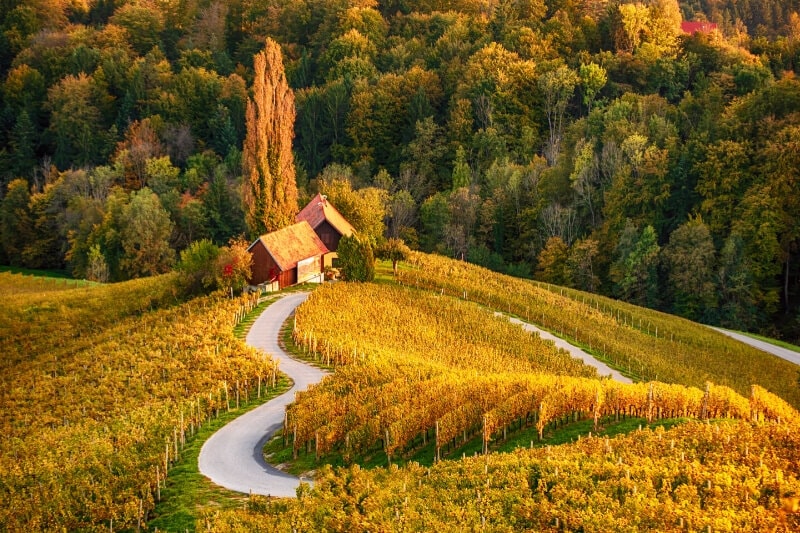
Trgatev, the annual grape harvest season, is one of the best times to visit Slovenia. As summer wanes, green Slovenia transitions to an autumnal palette and pickers take to their golden fields to collect the sun-ripened grapes.
Viticulture and wine-making is a sacred tradition in Slovenia, and the knowledge and techniques involved with hand-picking, crushing and fermenting grapes is passed down through families. During the harvest period, extended families, friends and neighbours assemble on vineyards to pitch-in. Many farms open their doors to tourists who wish to lend a hand.
The harvesting process is very auspicious and steeped in ritual. Days begin mid-morning when the heads of the household greet their guests and ceremoniously hand out special grape harvesting shears. Picking is accompanied by storytelling and singing, and in many vineyards, an accordion player is brought in to provide a backing track.
Slovenia has 14 separate wine districts spread across three official regions. In the warmer coastal area of Primorska, the harvest begins in late August. In Posavje and Podravje, picking starts later, around late September/October. Wine tastings in Bled and wine tours of the Vipava Valley are particularly enjoyable around this time. The Slovenian Wine Festival – the largest of many wine and food events on the country’s autumn calendar – is held in Ljubljana in November.
One of the best places to go for the wine harvest is Maribor in eastern Slovenia’s Lower Styria. Here, you’ll find Old Vine, which is featured in the Guinness World Records as the oldest grapevine in the world. The ceremonial harvesting of Old Vine takes place in October under a very steady, expertly trained pair of hands.
2. Kakheti, Georgia
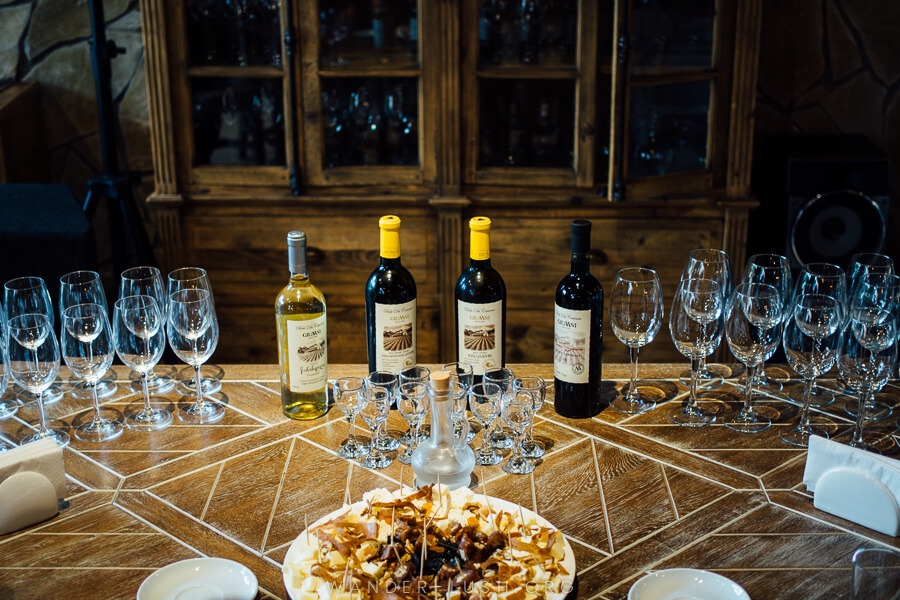
The earliest archaeological evidence of wine-making was unearthed in Eastern Georgia’s Kakheti region, so it only makes sense that this Caucasus nation should feature prominently on any wine lover’s to-drink list.
It’s been around since at least the 6th millennium BC, thus the art of making and drinking wine is an inseparable part of Georgian of culture. It’s also closely intertwined with religion. The Cross of St. Nino, Georgia’s patron, is fashioned from a curled grape vine, and many monasteries and nunneries produce their own wine.
Georgia is best known for qvevri wines, made by fermenting grapes in a clay vessel that’s buried in the earth. This method is associated with skin-contact wines – tannin-enriched, deep-coloured and full-bodied amber and red wines. There are more than 400 types of grape found in Georgia, including popular Rkatsitel, Mtsvane and Saperavi. Many commercial wineries combine qvevri and European techniques, while families and small-scale wineries observe ancestral methods.
The wine harvest in Georgia starts in late September and runs through to November. Known as Rtveli, it’s a huge celebration marked with feasts, festivals and other events across the country. Tbilisoba, the New Wine Festival, transforms Tbilisi into a wine drinker’s paradise.
Western Georgia produces some beautiful wines, but around 70% of the country’s grapes are grown in the east, making Kakheti the main harvest-season hub. Wineries throughout the Alazani Valley continue hosting their usual tours and tastings, and if you’re lucky, you might get an invite to participate in the picking.
Visitors can either join a wine-tasting tour from Tbilisi or go DIY, travelling to the town of Sighnaghi then exploring wine country by car.
3. La Rioja, Spain

La Rioja, a beautiful part of Northern Spain, is one of the country’s main wine regions. There are more than 500 wine estates in La Rioja, and many farms have tasting rooms that are open to visitors.
The best way to explore the area and to taste local wines is to follow one of the walking routes through the vineyards. Along the way, you can taste ripe grapes, witness the harvest, and stop at a couple of estates for wine tasting. Cycling wine tours are quite a popular activity for couples as well.
The harvest in La Rioja usually takes place in September. Logroño, the regional capital, is the best place to come for the wine harvest season.
Logroño is a gastronomical capital of Northern Spain, and the city is famous for its tapas bars where visitors can enjoy top quality local wines and delicious food.
Every year in mid-September, San Mateo Fiestas takes place in Logroño. Dedicated to the grape harvest, it’s a big celebration that attracts tourists from all over Europe. The main event is squeezing the must of the grapes in the traditional way – by pressing grapes with bare feet. The harvest celebration lasts for a couple of days.
Tempranillo is the most popular cultivar in La Rioja. Most local wines are 80-90% tempranillo (a dark grape used for full-bodied reds). Gran Reserva by La Rioja Alta estate and Viña El Pisón by Bodega Artadi are some of the most renowned wines of La Rioja.
By Alya and Campbell from Stingy Nomads
4. South Styria, Austria

Harvest is the best time to visit South Styria in southern Austria, part of the ‘Green Heart of Austria’. The region produces some of the best crisp white wines Austria is known for. A road trip along the South Styrian wine road rewards you with breathtaking views, plenty of small-town wine festivals, and excellent local food.
The region is famous for its excellent aromatic white wines such as Gelber Muskateller and Chardonnay, or Morillon. But without a doubt, Sauvignon Blanc steals the tasting show.
The 44-mile long wine road begins near Ehrenhausen and winds through quaint towns, past inviting wine taverns, until you reach the end of the loop near Leutschach. The route is easy to follow and best explored over the course of a few slow-paced days (it’s ideal if you have your own car). The breathtaking scenery is reminiscent of Tuscany with lush rolling hills and vineyards bursting with fruit.
Everyone gets in the spirit at harvest time, enjoying roasted chestnuts and stürm wine – the first wine press of the season. Visit the Leibnitz Wine Festival in late September and stay overnight at one of the buschenshanks near Gamlitz. They serve their own wines along with colourful cold dish platters overflowing with cured meats, cheeses, and local specialties.
Plan on spending harvest time in South Styria, one of Europe’s great undiscovered wine destinations.
By Lori from Travlinmad
5. Colmar, France

France is one of the top wine-producing countries in the world. While Bordeaux is the most famous wine region in France, it’s far from the only French destination to tour vineyards and enjoy a wine harvest.
One of France’s best cities for wine heritage is Colmar in the French Alsace. The Alsatian region is known for producing white wines from the four ‘noble’ grapes of Alsace: Pinot Gris, Riesling, Muscat and Gewurztraminer. Riesling is the most planted grape in the region and Colmar is famous for dry Rieslings that have a higher alcohol content than Rieslings from Germany.
The best way to experience wine culture and the wine harvest of Colmar is to visit for the Colmar Wine Festival in late July. It’s a massive city-wide event where you can sample the famous white wines of Colmar in the picturesque city streets. The enchanting half-timber houses make a perfect backdrop for the celebration.
Colmar’s wine houses showcase the harvest from late July through to September each year, and you can enjoy wine tours and tastings year-round. A popular wine tasting venue is Domain Martin Jund, which offers an authentic tasting experience from a family-run purveyor that’s been a Colmar staple for generations.
One of the best things to do in Colmar is enjoy a tasting and follow it up with a delicious Alsatian meal. Like many European cultures, it’s impossible to have the full Alsatian experience without enjoying local wine and unique cuisine.
By Derek and Mike from Robe Trotting
6. Tuscany, Italy

Tuscany is home to some of the most renowned wine districts in the world, including Chianti, Montepulciano and Vernaccia. Winemaking has been a tradition for hundreds of years in this area and is a huge part of the local culture, making a wine tasting in Italy a must-do for all oenophiles.
Vernaccia, which is produced in the hills around San Gimignano, was the very first wine to be granted the status of denominazione di origine controllata. This makes it illegal for wines produced anywhere else to be labeled as Vernaccia.
The harvest in Tuscany usually starts with the white grapes in mid to late August, and continues through to October. During these months, there are many harvest celebrations in the various wine districts. Just about every town will have its own harvest festival.
For example, in Greve, the Expo del Chianti Classico has been held annually in mid-September for the past 50 years. During the festival, there are many opportunities to taste Chianti wines as well as other local products.
While you’re there, visit the Querciabella winery, located just outside of Greve. Their wines are not only organic and biodynamic but are also among the best vegan wines in Tuscany.
If you’re wondering what could be non-vegan about wine, some winemakers use animal-based filters such as gelatin or casein to speed up the process of clarification. Another tipple worth seeking out is a Chianti DOCG Superiore called Vegante, produced by the Sensi winery in Lamporecchio.
By Wendy from The Nomadic Vegan
7. Northern Serbia
This Balkan nation is an under-appreciated wine country. There are a few distinct Serbian wine regions that visitors can tour to get an appreciation for the country’s great wine tradition.
The most famous wine from Serbia is Bermet, which was a favourite of the Austro-Hungarian elite and even served on the Titanic. This wine comes from the Srem wine region in Fruska Gora near Novi Sad.
Bermet is a spiced wine, and the recipe is a closely guarded secret, held by just a few families in the village of Sremski Karlovski. It makes a great Serbian souvenir, as its quite hard to find outside the country.
Another important wine region in Serbia is Subotica-Horgoš, centred on the beautiful town of Subotica just a few kilometres from the Hungarian border. Wine tourism here is popular, especially combining wine tours with relaxing on Lake Palic and exploring the town’s art nouveau architecture.
Other important wine regions in Serbia include the Timok valley, Vršac, Šumadija, and Župa. For such a tiny country, you might be shocked to learn that there are 9 classified wine regions, with a push by the government to break these down into 22 distinct microclimates.
By Stephanie from Sofia Adventures
8. Santorini, Greece

Santorini is undoubtedly the jewel of the Aegean, but it is also steeped in history from its seafaring and trading history. One of the products that has been made and traded since prehistoric times in Santorini is its delicious crisp white wines.
The island has a highly volcanic soil and a warm, dry climate – plus, it’s completely free of the phylloxera grape disease. This means Santorini has older vines than the rest of Greece.
There are well over a dozen wineries and surprisingly, they are dotted all over the island. It can be hard choosing between the best wineries and wine tasting tours, but certainly the two most spectacular wineries are Santo and Venesanto wineries because you can sip a glass of wine while looking out at the volcano as the famous Santorini sunset.
Whilst Assytiko wine is definitely my favourite dry white Santorini wine, Vinsanto, Aidani and Athiri also have Santorini PDO status (Protected Designation of Origin).
Santorini vines are not grown on trellises and trained as in other places. They are shaped instead into a basket shape on the ground (called ambelia or kouloura) which protects them from fierce winds and the heat.
Santorini’s grape harvesting season is known as Vedema and is a non-stop party with pickers coming from all over the world in the middle of the tourist season. From late July until mid-September, the grapes are picked and trodden. The wine is kept in barrels until the 22nd of October, which is the Feast of St. Averkios.
By Monique from TripAnthropologist
9. Bratislava, Slovakia

Not many people consider Bratislava (the capital of Slovakia) and its surroundings as a wine destination, but this part of Central Europe is actually perfect for wine lovers.
The Wine Road through the Little Carpathian mountains runs from Bratislava to Trnava through old royal towns such as Svätý Jur, Pezinok and Modra. Each of them offers small, family-owned wine cellars where you can try local wines.
In September, when the grape harvest takes place, there are a few wine festivals in the region that are usually accompanied by folk music concerts and other events. Twice a year, in May and November, visitors can attend the so-called Wine Cellars Open Day. A ticket includes a souvenir wine glass and entrance to as many cellars as you wish (or can manage to) visit. You can choose from over a hundred different wines in total.
This is the best time to visit the Wine Road, but even outside of these events, it’s worth visiting this picturesque region of Slovakia at any time of year. Some of the most popular wines from the region are Rizling vlašský, Rizling rýnsky or Veltlínske zelené. Discovering the Wine Road and the local wine culture is one of the best things to do in Bratislava.
By Kami from Kami and the Rest of the World
10. The Rhein Valley, Germany
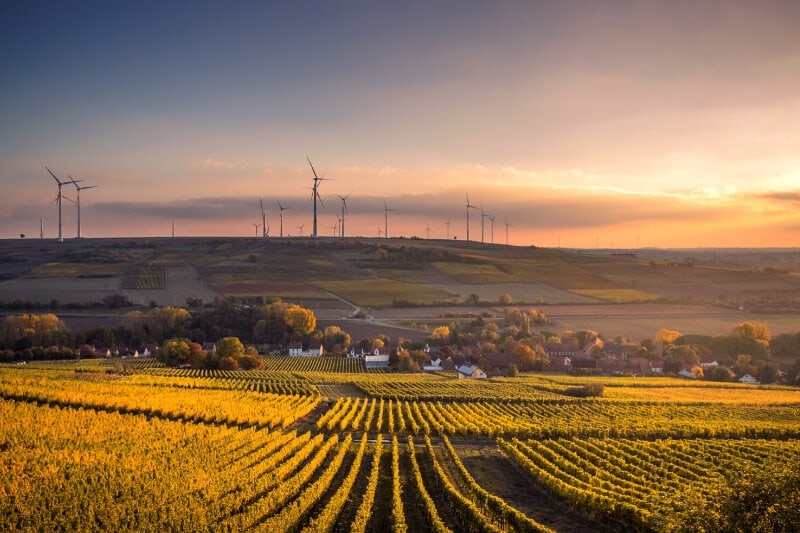
The Rhein Valley (Rhine Valley) is Germany’s most famous wine-producing region. It stretches along the steep banks of the Rhein River as it flows between Mainz and Düsseldorf. While the region produces several styles of wine, it has gained international recognition for its fantastic white wines made from Reisling grapes.
Riesling is one of the oldest wines originating from Germany and it is known for its light, aromatic body that has hints of citrus fruits. As a versatile wine, it can easily be paired with many foods and is a staple at any German cookout. While exploring the charming towns of the Rheingau, including Rüdesheim, there are plenty of seasonal and year-round wine bars where you can taste the local beverages.
Due to the high acidity of the grapes, they tend to be harvested in early autumn. During the harvest period, towns along the Rheingau come alive with festivals, and it’s common to find locals and visitors heading out into the autumnal vineyards to help with harvesting the grapes.
One of the best things to do during the harvest season is find a small and hidden wine bar in the Rheingau where you can enjoy a traditional harvest treat of the season’s New Wine and onion cake (Federweiße und Zweibelkuchen). New wine is a sweet wine that has only just begun to ferment, with about 5% alcohol volume. It’s an easy drink that pairs well with the salty, robust onion cake.
By Megan from Megan Starr
11. the Douro Valley, Portugal

The harvest season is the most vibrant and tasty time of the year in northern Portugal’s Douro Valley, one of the country’s must-visit destinations.
The Douro Valley is the oldest demarcated wine region in the world and a UNESCO World Heritage site. Deeply cut by the Douro River, the valley features steep, terraced vineyards on both sides, creating a striking contoured landscape. The region is best known for port wine, a fortified wine made by adding a strong alcohol spirit.
The harvest usually begins (depending on the weather) in mid-September. Relying on the ‘old ways’, the grapes are picked by hand and stomped by groups of people who keep time with music. The blends are made according to recipes passed down through the generations.
During the season, many of the wineries (quintas) invite visitors to join in on the grape picking or stomping, followed by wine tasting and traditional food. This makes for one of the top immersive experiences in Portugal.
The best way to visit is by car or by train. Portugal’s train system even offers a special Wine Harvest Festival trip from Porto that includes a winery visit.
Want to try some local port? An excellent place to start is with an elegant 10-year old Burmester or a classic Taylor Fladgate Tawny Port.
By Cindy from Travel Bliss Now
12. Tenerife, Spain
Tenerife in the Spanish Canary Islands has a reputation for sun and fun – but it’s also home to some amazing Spanish wines.
When people hear ‘Spanish wine’, they naturally think of the main wine regions of Rioja, Priorat and Ribera del Duero. But don’t discount wines from the Canary Islands including Tenerife. With a long history of producing wine, the islands’ unique climate and terroir produce wines that are unlike any others found throughout Spain.
Despite its distance from the Spanish mainland, the wine harvest is celebrated on Tenerife as it is in the rest of the country. Every September, the Tenerife Wine Route kicks off, offering visitors and local wine lovers alike an opportunity to explore the island’s wineries and bodegas.
Many of the 70 wineries on Tenerife open their doors to the public and offer tastings, food pairing and tours of the vineyard. Bodegas El Lomo and Bodegas Suertes del Marqués are two wineries that are definitely worth a visit. In addition to producing incredible wines, the tasting rooms here offer breathtaking views of Tenerife.
Another stop worth making is the Tenerife Wine Museum, which documents the extensive history of Tenerife wine as well as offering tastings and educational classes.
By Amber from Food And Drink Destinations
13. The Aeolian Islands, Sicily
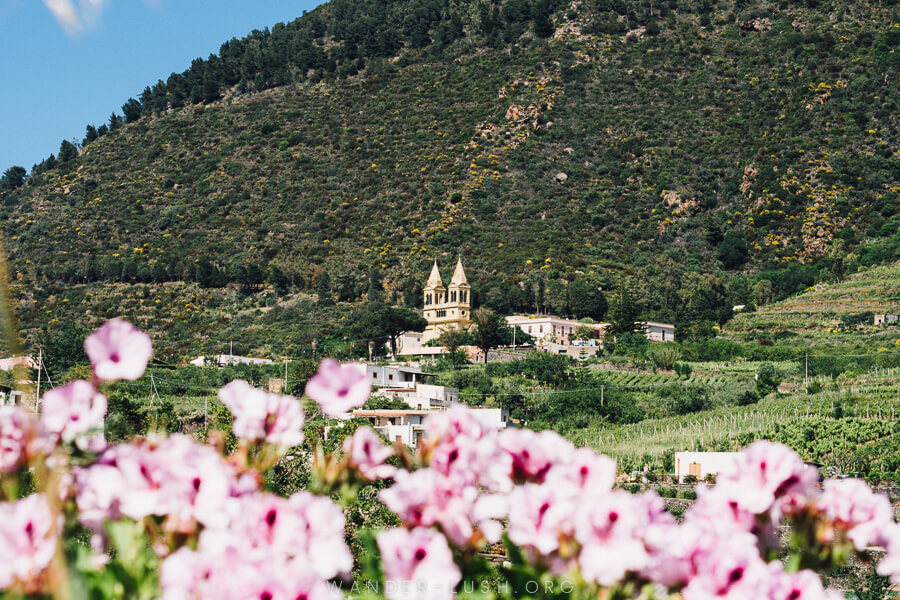
The Aeolian Islands off the coast of north-western Sicily are synonymous with semi-sweet malvasia wine. Malvasia grapes have been grown here and throughout the Mediterranean for centuries, and many wine-makers adhere to ancestral techniques even today.
The islands’ mineral-rich volcanic soils are the ideal environment for cultivating grapes. On Salina, the ‘Green Island’ and Lipari, vineyards stretch out along every precious inch of flat plateau against a picturesque backdrop of soaring craters. Both islands boast dozens of small family-run and commercial wineries, many of which welcome guests for informal tours and tastings.
Compared to other Italian islands, the Aeolian arc is a relatively off-the-beaten-track destination for wine tourism. A great time to visit is during the the vendemmia grape harvest, which typically begins in Sicily in August and continues through until the end of September. Seasonal workers pour into vineyards across the islands and on the mainland to assist with the picking.
World-renowned Passito di Malvasia delle Lipari, a warm and sweet amber-coloured dessert wine, is a must-try. Malvasia wines pair particularly well with local island produce, including capers.
14. Croatian Istria

Despite spanning two of Europe’s most celebrated wine countries, Croatia and Slovenia, the Istrian Peninsula is still relatively under-appreciated in terms of wine tourism.
Grapes were introduced to this region by the Greeks as early as the 6th century BC, making Istria one of Europe’s oldest wine-making regions.
Wine is an integral part of Istrian gastronomy and as the region’s reputation for produce and food culture has grown, so too have its wine-makers benefited from increased interest and investment. That’s despite phylloxera having decimated the region’s vines in the early 20th century – just 4,000 hectares (compared to 44,000 hectares) remain today.
Croatian Istria boasts three distinct types of soil (red, grey and white) that each lend themselves to different varieties of grape. The iron-rich red soil near the coast is ideal for full-bodied reds, while limestone-enriched grey soils and rocky white soils yield acidic white grapes.
There are wineries of various sizes all over the Istrian Peninsula, dotted between the region’s cute towns and villages. The harvest takes place during September, but wine-themed events are held from May through until November. The autumn calendar is so packed with parties and festivals, there’s bound to be some unique experience of offer no matter which weekend you visit.
The biggest festivity, the Day of Open Wine Cellars, takes place in the final weeks of May, when wine-makers open to the public to showcase the best of last season’s vintage. This is an ideal time to sample Istrian Malvasia and Momjan Muscat. Meanwhile, the latest teran wines can be sipped at the Teran and Truffle Festival in the town of Motovun.
The coastal city of Rovinj hosts an annual Wine Festival in mid-September, where the traditional tractor-driven harvesting process is demonstrated. Finally, the Feast Day of St. Martin, patron saint of vintners, is marked in Momjan and Buje every November 11.
15. Moselle Valley, Luxembourg

The southeast of Luxembourg is filled with wineries. The continuous history of winemaking in this area dates back to the times of Ancient Rome. The main wine region runs for 42 kilometres along the Moselle River, right on the border with Germany. Wine harvest season in Luxembourg starts in September.
The Moselle Valley is one of the main tourist attractions in Luxembourg. The natural beauty of the area’s hilly vineyards and warm climate make it an outstanding place for wine tourism. In September and October, the area hosts a number of wine festivals, including Schwéidsbenger Wäifescht, Riesling Open, Hunnefeier Schengen, and the largest of all, Grevenmacher Wine and Grape Festival.
Gevenmachen Festival happens every year in the second week of September. In 2019, it celebrated its 70-year anniversary. During the festival, you can see folk bands and performance groups. A wine queen is voted on, and fireworks are displayed over the Moselle.
Luxembourg’s specialty is late-harvest wines. To make them, winemakers push the harvest date back as late as possible to improve the grapes’ sugar content. Award-winning Domaines Vinsmoselle Poll-Fabaire Cremant and Bernard Massard Selection Brut are both must-trys.
By Alexander from Engineer On Tour
16. Lavaux, Switzerland
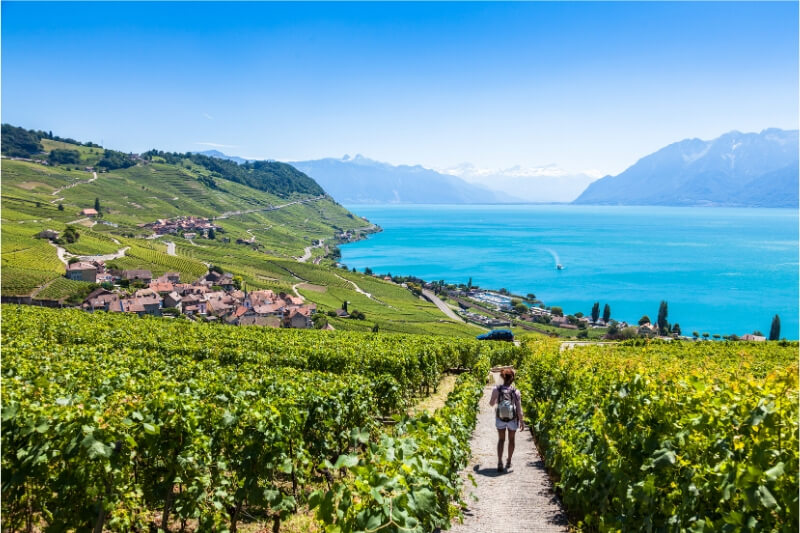
Wine is an important part of every meal (except maybe breakfast) in Switzerland. All the country’s major dishes pair nicely with wine – be it fondue, raclette, or rösti. The evening time apéro is specially designed around wine and cheese.
One of the most famous regions where these wines are produced is Lavaux in the French part of Switzerland. The Heritage Listed Lavaux Vineyards are located on the beautiful sloped terraces next to Lake Geneva and have been around since the 11th century. Although they make both red and white wines, this region is best known for its whites.
The harvest usually takes place in September and is celebrated with open cellars, the Fetes de Vedanges. During the event, you can wander from wine cellar to wine cellar, sampling as much wine as you like.
Every Sunday between June and October, guided tours start from Cully pier (Place d’Armes). You can pay 20 Swiss Francs for a wine tasting, and receive a complimentary wine glass as a souvenir. Recommended wines to try include Dezaley Grand Cru and Epesses Sauvignon Blanc.
You can take your wine knowledge to an even higher level by spending the day with a local winemaker. This might include working in the vineyard or the cellar (depending on the season), visiting the estate, wine tasting with a snack, and a bottle of wine to take home. If you’re interested, it’s recommended to book at least one week in advance.
Another highlight is the once-in-a-generation wine festival in Vevey, La fete des Vignerons. It takes place every 20 to 25 years. This month-long festival dates all the way back to the Middle Ages and pays homage to the entire area’s viticultural traditions. The last edition was in 2019, so you’ll have to wait a few years for the next one!
By Nisha from Nerdy Footsteps
17. Odessa, Ukraine
As underrated as it might be, many are surprised to learn that wine-making has long been a well-established tradition in Ukraine. There are winemakers in the Carpathian Mountains, and several wine harvest festivals in Lviv. But the country’s most popular wine region is found in Southern Ukraine, in the city of Odessa. It is one of four major grape-growing regions, the others being Mykolaiv, Kherson and Dnipropetrovsk.
There are several wineries in Odessa. The local’s favourite is located in the old Swiss colony of Shabo, in the Belgorod-Dniester District. From Odessa, you should plan a half-day tour to the Shabo Wine Culture Center to learn about production and sample their best wines.
Even if you’re only planning a short visit to Odessa, make sure you include a wine tour in your one day in Odessa Itinerary. Tour can also be organised beyond Shabo to places such as the Institute of Viticulture and Winemaking Tairova, Kolonist, Vinaria and Bolgrad.
The grapes are harvested by hand in late August/early September (but sometimes pickings occur as late in October) and, within 15 minutes, are transported to the processing facility for sorting. The favourable microclimate and soil, along with other high quality characteristics, makes grapes from this part of Ukraine highly sought-after.
The main varieties of grapes in Ukraine are Aligote, Muscat, Isabella, Traminer, Cabernet Sauvignon, Chardonnay, Pinot Noir, Pinot Gris and Rkatsiteli. If you’re looking for something unique, Merlot Reserve by Shabo, Shabo’s Classic Chardonnay and Chardonnay Villa Tinta are all worth a try.
– By Olga Maria from All Things Ukraine
18. Bordeaux, France

Bordeaux is the World Capital of Wine and home to one of the most famous wine blends in the world. Come September, Bordeaux is a flurry of activity as teams of grape pickers take to the more than 7,000 vineyards that make up the Bordeaux wine region to harvest the grapes.
Winemakers and their teams turn their full attention to the process of transforming grapes into wine as the trucks of grapes arrive at the winery. The Bordeaux wine harvest season, which typically occurs for around three weeks in September, depending on weather conditions, is undoubtedly one of the most exciting times to visit the region.
While the harvest in Bordeaux isn’t a touristic event that allows visitors to stomp grapes or even pick them, many châteaux continue to offer visits. Head to small family-run wineries such as Château Cantenac in Saint-Émilion where you might even get a taste of the day’s freshly crushed grape juice. In the Médoc at Château Léoville Poyferre, visitors can watch as the grapes arrive from the vineyards and go through the sorting process as a special addition to the classic winery tour.
If you happen to be in Bordeaux’s Saint-Émilion appellation at the very start of the harvest, you can attend the village festival in which the Jurade de Saint-Émilion – the brotherhood of Saint-Émilion wines – declares the official start of the grape harvest with a parade and a lot of pomp and circumstance.
It’s all quite the spectacle to see and there’s nothing as memorable as tasting the freshly crushed juice straight from the vines.
By Jennifer from Bordeaux Travel Guide
